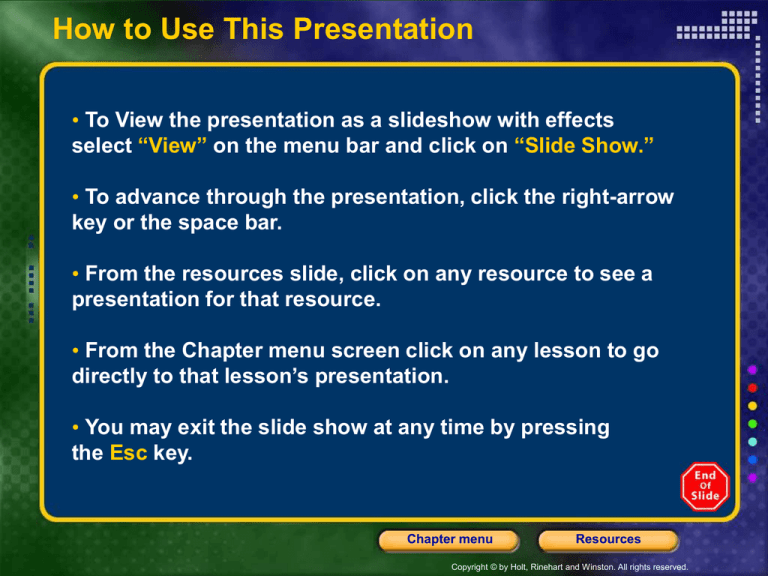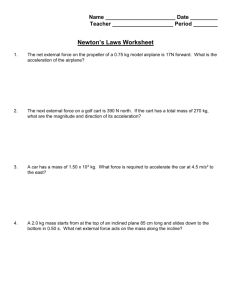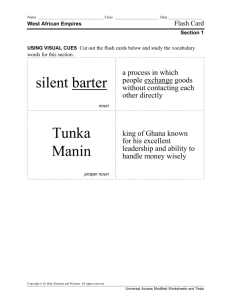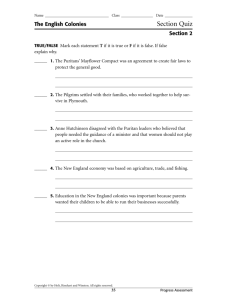
How to Use This Presentation
• To View the presentation as a slideshow with effects
select “View” on the menu bar and click on “Slide Show.”
• To advance through the presentation, click the right-arrow
key or the space bar.
• From the resources slide, click on any resource to see a
presentation for that resource.
• From the Chapter menu screen click on any lesson to go
directly to that lesson’s presentation.
• You may exit the slide show at any time by pressing
the Esc key.
Chapter menu
Resources
Copyright © by Holt, Rinehart and Winston. All rights reserved.
Resources
Chapter Presentation
Visual Concepts
Transparencies
Standardized Test Prep
Chapter menu
Resources
Copyright © by Holt, Rinehart and Winston. All rights reserved.
Chapter 37
Introduction to Body Structure
Table of Contents
Section 1 Body Organization
Section 2 Skeletal System
Section 3 Muscular System
Section 4 Skin, Hair, and Nails
Chapter menu
Resources
Copyright © by Holt, Rinehart and Winston. All rights reserved.
Chapter 37
Section 1 Body Organization
Objectives
• Identify four levels of structural organization within
the human body.
• Analyze the four kinds of body tissues.
• List the body’s major organ systems.
• Evaluate the importance of endothermy in
maintaining homeostasis.
Chapter menu
Resources
Copyright © by Holt, Rinehart and Winston. All rights reserved.
Chapter 37
Section 1 Body Organization
Levels of Structural Organization
• The body is organized into four levels: cells, tissues,
organs, and organ systems.
• A tissue is a group of similar cells that work together
to perform a common function.
• The body has four basic kinds of tissues: epithelial,
nervous, connective, and muscle tissues.
Chapter menu
Resources
Copyright © by Holt, Rinehart and Winston. All rights reserved.
Chapter 37
Section 1 Body Organization
Tissue, Organ, and Organ System
Chapter menu
Resources
Copyright © by Holt, Rinehart and Winston. All rights reserved.
Chapter 37
Section 1 Body Organization
Levels of Structural Organization, continued
Four Kinds of Tissues
• Epithelial tissue lines most body surfaces and
protects other tissues from damage and dehydration.
• Nervous tissue consists of nerve cells, which carry
information throughout the body.
• Various kinds of connective tissue support, protect,
and insulate the body.
• Muscle tissue enables the movement of body
structures by muscle contraction.
Chapter menu
Resources
Copyright © by Holt, Rinehart and Winston. All rights reserved.
Chapter 37
Section 1 Body Organization
Human Body Tissues
Chapter menu
Resources
Copyright © by Holt, Rinehart and Winston. All rights reserved.
Chapter 37
Section 1 Body Organization
Body Tissues
Chapter menu
Resources
Copyright © by Holt, Rinehart and Winston. All rights reserved.
Chapter 37
Section 1 Body Organization
Levels of Structural Organization, continued
Stem Cells
• Embryonic stem cells are early, undifferentiated cells
that give rise to all of the types of cells in the
developing body.
• Embryonic stem cells will divide indefinitely.
• Adult stem cells are not as versatile and do not divide
indefinitely.
Chapter menu
Resources
Copyright © by Holt, Rinehart and Winston. All rights reserved.
Chapter 37
Section 1 Body Organization
Organ Systems
• Body organs are made of combinations of two or
more types of tissues working together to perform a
specific function.
• An organ system is a group of organs that work
together to carry out major activities or processes.
Some organs function in more than one organ
system.
Chapter menu
Resources
Copyright © by Holt, Rinehart and Winston. All rights reserved.
Chapter 37
Section 1 Body Organization
Major Organ Systems of the Human Body
Chapter menu
Resources
Copyright © by Holt, Rinehart and Winston. All rights reserved.
Chapter 37
Section 1 Body Organization
Overview of Organ Systems
Chapter menu
Resources
Copyright © by Holt, Rinehart and Winston. All rights reserved.
Chapter 37
Section 1 Body Organization
Organ Systems, continued
Body Cavities
• The human body contains four large fluid-filled
spaces, or body cavities, that house and protect the
major internal organs.
• These body cavities are the thoracic cavity (heart and
lungs), cranial cavity (brain), abdominal cavity
(digestive organs), and spinal cavity (spinal cord).
Chapter menu
Resources
Copyright © by Holt, Rinehart and Winston. All rights reserved.
Chapter 37
Section 1 Body Organization
Cavities of the Human Body
Chapter menu
Resources
Copyright © by Holt, Rinehart and Winston. All rights reserved.
Chapter 37
Section 1 Body Organization
Inside the Human Coelom
Chapter menu
Resources
Copyright © by Holt, Rinehart and Winston. All rights reserved.
Chapter 37
Section 1 Body Organization
Human Body Cavities
Chapter menu
Resources
Copyright © by Holt, Rinehart and Winston. All rights reserved.
Chapter 37
Section 1 Body Organization
Organ Systems, continued
Endothermy
• Like all mammals, humans are endotherms. Humans
maintain a fairly constant internal temperature of
about 37°C (98.6 °F).
• The human body uses a great deal of energy to
maintain a constant body temperature.
Chapter menu
Resources
Copyright © by Holt, Rinehart and Winston. All rights reserved.
Chapter 37
Section 1 Body Organization
Advantage of Endothermy
Chapter menu
Resources
Copyright © by Holt, Rinehart and Winston. All rights reserved.
Chapter 37
Section 2 Skeletal System
Objectives
• Distinguish between the axial skeleton and the
appendicular skeleton.
• Analyze the structure of bone.
• Summarize the process of bone development.
• List two ways to prevent osteoporosis.
• Identify the three main classes of joints.
Chapter menu
Resources
Copyright © by Holt, Rinehart and Winston. All rights reserved.
Chapter 37
Section 2 Skeletal System
The Skeleton
• The human skeleton contains 206 individual bones.
• The bones of the skull, spine, ribs, and sternum form
the axial skeleton.
• The other bones, including those of the arms, legs,
pelvis, and shoulder, form the appendicular
skeleton.
Chapter menu
Resources
Copyright © by Holt, Rinehart and Winston. All rights reserved.
Chapter 37
Section 2 Skeletal System
Human Skeleton
Chapter menu
Resources
Copyright © by Holt, Rinehart and Winston. All rights reserved.
Chapter 37
Section 2 Skeletal System
Anatomy of a Human Skeletal System
Chapter menu
Resources
Copyright © by Holt, Rinehart and Winston. All rights reserved.
Chapter 37
Section 2 Skeletal System
The Skeleton, continued
Axial Skeleton
• The most complex part of the axial skeleton is the
skull. The skull is attached to the top of the spine, or
backbone, which is a flexible, curving column of
vertebrae.
• Curving forward from the middle vertebrae are 12
pairs of ribs, which form the rib cage.
Chapter menu
Resources
Copyright © by Holt, Rinehart and Winston. All rights reserved.
Chapter 37
Section 2 Skeletal System
The Skeleton, continued
Appendicular Skeleton
• The appendicular skeleton forms the appendages, or
limbs—the shoulders, arms, hips, and legs.
• The shoulder attachment is called the pectoral girdle.
The hip attachment is called the pelvic girdle.
Chapter menu
Resources
Copyright © by Holt, Rinehart and Winston. All rights reserved.
Chapter 37
Section 2 Skeletal System
The Skeleton, continued
Structure of Bone
• Bones are made of a hard outer covering of compact
bone surrounding an inner core of spongy bone.
• Some cavities in spongy bone are filled with a soft
tissue called bone marrow.
• Bones are surrounded and protected by a tough
exterior membrane called the periosteum.
Chapter menu
Resources
Copyright © by Holt, Rinehart and Winston. All rights reserved.
Chapter 37
Section 2 Skeletal System
Parts of a Human Bone — 1 & 2
Chapter menu
Resources
Copyright © by Holt, Rinehart and Winston. All rights reserved.
Chapter 37
Section 2 Skeletal System
Bone Marrow and Production of Red Blood
Cells
Chapter menu
Resources
Copyright © by Holt, Rinehart and Winston. All rights reserved.
Chapter 37
Section 2 Skeletal System
Structure of Bone
Chapter menu
Resources
Copyright © by Holt, Rinehart and Winston. All rights reserved.
Chapter 37
Section 2 Skeletal System
Growth of Bones
• During development, a type of connective tissue
called cartilage is gradually replaced by bone as
minerals are deposited.
• In compact bone, new bone cells are added in layers
around narrow, hollow channels called Haversian
canals.
• Bone cells called osteocytes maintain the mineral
content of bone.
Chapter menu
Resources
Copyright © by Holt, Rinehart and Winston. All rights reserved.
Chapter 37
Section 2 Skeletal System
Compact Bone
Chapter menu
Resources
Copyright © by Holt, Rinehart and Winston. All rights reserved.
Chapter 37
Section 2 Skeletal System
Human Bone Growth
Chapter menu
Resources
Copyright © by Holt, Rinehart and Winston. All rights reserved.
Chapter 37
Section 2 Skeletal System
Growth of Bones, continued
Osteoporosis
• In young adults, the density of bone usually remains
constant.
• Severe bone loss can lead to a condition called
osteoporosis. In osteoporosis, bones become brittle
and are easily fractured.
Chapter menu
Resources
Copyright © by Holt, Rinehart and Winston. All rights reserved.
Chapter 37
Section 2 Skeletal System
Effects of Osteoporosis
Chapter menu
Resources
Copyright © by Holt, Rinehart and Winston. All rights reserved.
Chapter 37
Section 2 Skeletal System
Osteoporosis
Chapter menu
Resources
Copyright © by Holt, Rinehart and Winston. All rights reserved.
Chapter 37
Section 2 Skeletal System
Joints
• A joint is a place where two bones meet. Pads of
cartilage cushion the ends of the bones of a joint,
enabling the joint to withstand great pressure and
stress.
• The bones of a joint are held together by strong
bands of connective tissue called ligaments.
Chapter menu
Resources
Copyright © by Holt, Rinehart and Winston. All rights reserved.
Chapter 37
Section 2 Skeletal System
Joints in the Human Body
Chapter menu
Resources
Copyright © by Holt, Rinehart and Winston. All rights reserved.
Chapter 37
Section 2 Skeletal System
Joints, continued
Three Main Types of Joints
• Immovable joints permit little or no movement of the
bones they join (ex. cranial bones).
• Slightly movable joints permit limited movement of
the bones they join (ex. rib cage).
• Freely movable joints (ex. knee) permit movement.
The direction of bone movement is determined by
the structure of the joint.
Chapter menu
Resources
Copyright © by Holt, Rinehart and Winston. All rights reserved.
Chapter 37
Section 2 Skeletal System
The Human Knee
Chapter menu
Resources
Copyright © by Holt, Rinehart and Winston. All rights reserved.
Chapter 37
Section 2 Skeletal System
Types of Joints
Chapter menu
Resources
Copyright © by Holt, Rinehart and Winston. All rights reserved.
Chapter 37
Section 2 Skeletal System
Joints, continued
Disorders of Joints
• When a disease afflicts the bones, connective tissue,
or lubricating tissues in a freely movable joint, the
joint’s ability to move may be impaired.
• Rheumatoid arthritis is a painful inflammation of
freely movable joints. Osteoarthritis is a disorder that
causes the degeneration of cartilage that covers the
surfaces of bones.
Chapter menu
Resources
Copyright © by Holt, Rinehart and Winston. All rights reserved.
Chapter 37
Section 2 Skeletal System
Rheumatoid Arthritis
Chapter menu
Resources
Copyright © by Holt, Rinehart and Winston. All rights reserved.
Chapter 37
Section 2 Skeletal System
Osteoarthritis
Chapter menu
Resources
Copyright © by Holt, Rinehart and Winston. All rights reserved.
Chapter 37
Section 3 Muscular System
Objectives
• Describe the action of muscle pairs in moving the
body.
• Relate the structure of a skeletal muscle to the
muscle’s ability to contract.
• Describe how energy is supplied to muscles for
contraction.
Chapter menu
Resources
Copyright © by Holt, Rinehart and Winston. All rights reserved.
Chapter 37
Section 3 Muscular System
Muscles and Movement
• Movement requires precisely timed and controlled
contractions of many skeletal muscles.
• Even when the body is still, many skeletal muscles
remain partially contracted to maintain balance and
posture.
Chapter menu
Resources
Copyright © by Holt, Rinehart and Winston. All rights reserved.
Chapter 37
Section 3 Muscular System
Anatomy of the Muscular System
Chapter menu
Resources
Copyright © by Holt, Rinehart and Winston. All rights reserved.
Chapter 37
Section 3 Muscular System
Muscles and Movement, continued
Movement of the Skeleton
• Most skeletal muscles are attached to bones by strips
of dense connective tissue called tendons.
• A flexor muscle causes a joint to bend. An extensor
muscle causes a joint to straighten.
Chapter menu
Resources
Copyright © by Holt, Rinehart and Winston. All rights reserved.
Chapter 37
Section 3 Muscular System
Opposing Muscles in the Arm
Chapter menu
Resources
Copyright © by Holt, Rinehart and Winston. All rights reserved.
Chapter 37
Section 3 Muscular System
Muscular Movement and Bones
Chapter menu
Resources
Copyright © by Holt, Rinehart and Winston. All rights reserved.
Chapter 37
Section 3 Muscular System
Muscles and Movement, continued
Muscle Structure
• Muscle contains contractile protein filaments called
actin and myosin.
• Each skeletal muscle fiber contains small cylindrical
structures called myofibrils. Sections of protein
filaments that contract together are called
sarcomeres.
Chapter menu
Resources
Copyright © by Holt, Rinehart and Winston. All rights reserved.
Chapter 37
Section 3 Muscular System
Skeletal Muscle
Chapter menu
Resources
Copyright © by Holt, Rinehart and Winston. All rights reserved.
Chapter 37
Section 3 Muscular System
Muscle Fiber
Chapter menu
Resources
Copyright © by Holt, Rinehart and Winston. All rights reserved.
Chapter 37
Section 3 Muscular System
Close-Up of a Skeletal Muscle
Chapter menu
Resources
Copyright © by Holt, Rinehart and Winston. All rights reserved.
Chapter 37
Section 3 Muscular System
Muscle Contraction
• Muscle contraction occurs in the sarcomeres of
myofibrils.
• Myosin and actin filaments slide along one another
and a sarcomere shortens, resulting in muscle
contraction.
Chapter menu
Resources
Copyright © by Holt, Rinehart and Winston. All rights reserved.
Chapter 37
Section 3 Muscular System
Contraction of a Muscle
Chapter menu
Resources
Copyright © by Holt, Rinehart and Winston. All rights reserved.
Chapter 37
Section 3 Muscular System
Muscle Contraction
Chapter menu
Resources
Copyright © by Holt, Rinehart and Winston. All rights reserved.
Chapter 37
Section 3 Muscular System
Muscle Contraction, continued
Interaction of Myosin and Actin
• Myosin filaments have long, finger-like projections
with an enlarged “head” at one end.
• Myosin heads attach to binding sites on actin
filaments and then rotate, causing the actin filament
to slide. Muscle contraction occurs.
Chapter menu
Resources
Copyright © by Holt, Rinehart and Winston. All rights reserved.
Chapter 37
Section 3 Muscular System
Interaction of Muscle Protein Filaments
Chapter menu
Resources
Copyright © by Holt, Rinehart and Winston. All rights reserved.
Chapter 37
Section 3 Muscular System
Muscle Contraction, continued
Aerobic and Anaerobic Energy Pathways
• Muscle contractions use ATP supplied by aerobic
respiration. During brief, intense activities, anaerobic
processes take over and ATP is produced by
glycolysis.
• When both aerobic and anaerobic pathways become
insufficient, muscles use glycogen as an energy
source.
Chapter menu
Resources
Copyright © by Holt, Rinehart and Winston. All rights reserved.
Chapter 37
Section 3 Muscular System
Muscle Contraction, continued
Exercise and Fitness
• Consistent aerobic exercise makes the heart pump
more efficiently.
• Resistance exercises, such as weight lifting, can
increase muscle size and strength.
Chapter menu
Resources
Copyright © by Holt, Rinehart and Winston. All rights reserved.
Chapter 37
Section 3 Muscular System
Aerobic Exercise
Chapter menu
Resources
Copyright © by Holt, Rinehart and Winston. All rights reserved.
Chapter 37
Section 4 Skin, Hair, and Nails
Objectives
• Analyze the structure and function of the epidermis.
• Describe how the dermis helps the body maintain
homeostasis.
• Summarize how hair and nails are formed.
• Identify various types of skin disorders.
Chapter menu
Resources
Copyright © by Holt, Rinehart and Winston. All rights reserved.
Chapter 37
Section 4 Skin, Hair, and Nails
Skin
• The skin in the largest organ in the body.
• Along with the hair and nails, the skin forms the
integumentary system.
• The two primary layers of skin are the epidermis and
the dermis.
Chapter menu
Resources
Copyright © by Holt, Rinehart and Winston. All rights reserved.
Chapter 37
Section 4 Skin, Hair, and Nails
Skin, continued
Epidermis
• The epidermis is the outermost layer of the skin. It is
made of several layers of epithelial cells.
• Keratin is a protein that makes skin tough and
waterproof.
• The inner layer of the epidermis contains cells that
produce the pigment melanin.
Chapter menu
Resources
Copyright © by Holt, Rinehart and Winston. All rights reserved.
Chapter 37
Section 4 Skin, Hair, and Nails
Structure of Skin
Chapter menu
Resources
Copyright © by Holt, Rinehart and Winston. All rights reserved.
Chapter 37
Section 4 Skin, Hair, and Nails
Human Skin
Chapter menu
Resources
Copyright © by Holt, Rinehart and Winston. All rights reserved.
Chapter 37
Section 4 Skin, Hair, and Nails
Skin, continued
Dermis
• The dermis is the functional layer of skin that lies just
beneath the epidermis.
• The dermis contains nerve cells, blood vessels, and
hair follicles.
Chapter menu
Resources
Copyright © by Holt, Rinehart and Winston. All rights reserved.
Chapter 37
Section 4 Skin, Hair, and Nails
Skin, continued
Subcutaneous Tissue
• Subcutaneous tissue is a layer of connective tissue
made mostly of fat. It lies just beneath the dermis.
Chapter menu
Resources
Copyright © by Holt, Rinehart and Winston. All rights reserved.
Chapter 37
Section 4 Skin, Hair, and Nails
Parts of the Skin
Chapter menu
Resources
Copyright © by Holt, Rinehart and Winston. All rights reserved.
Chapter 37
Section 4 Skin, Hair, and Nails
Skin, continued
Hair and Nails
• Hair and nails are derived from the epidermis.
• Hair follicles produce individual hairs. Nails are
produced by specialized epidermal cells located at
the base of each nail.
Chapter menu
Resources
Copyright © by Holt, Rinehart and Winston. All rights reserved.
Chapter 37
Section 4 Skin, Hair, and Nails
Cross Section of a Fingernail
Chapter menu
Resources
Copyright © by Holt, Rinehart and Winston. All rights reserved.
Chapter 37
Section 4 Skin, Hair, and Nails
Skin Disorders
• Most skin injuries heal rapidly. Burns, however, can
result in permanent scarring or even death.
• Some skin disorders are the result of changes that
occur within the body over time.
Chapter menu
Resources
Copyright © by Holt, Rinehart and Winston. All rights reserved.
Chapter 37
Section 4 Skin, Hair, and Nails
Skin Disorders, continued
Acne
• Oil glands in the dermis release sebum, an oily
secretion that lubricates the skin.
• Acne is a chronic, inflammatory skin condition caused
by an excessive secretion of sebum, which blocks
pores with oil, dirt, and bacteria.
Chapter menu
Resources
Copyright © by Holt, Rinehart and Winston. All rights reserved.
Chapter 37
Section 4 Skin, Hair, and Nails
Skin Disorders, continued
Skin Cancer
• Skin cancer can result from genetic mutations caused
by overexposure to UV radiation.
• Carcinomas are skin cancers that originate in cells
that do not produce pigments. Cancers in pigmentproducing cells are called malignant melanomas.
Chapter menu
Resources
Copyright © by Holt, Rinehart and Winston. All rights reserved.
Chapter 37
Standardized Test Prep
Multiple Choice
Use the art below and your knowledge of science to
answer questions 1–3.
Chapter menu
Resources
Copyright © by Holt, Rinehart and Winston. All rights reserved.
Chapter 37
Standardized Test Prep
Multiple Choice, continued
1. The structure labeled X is a
A.
B.
C.
D.
myosin filament
muscle fiber
myofibril
Z line
Chapter menu
Resources
Copyright © by Holt, Rinehart and Winston. All rights reserved.
Chapter 37
Standardized Test Prep
Multiple Choice, continued
1. The structure labeled X is a
A.
B.
C.
D.
myosin filament
muscle fiber
myofibril
Z line
Chapter menu
Resources
Copyright © by Holt, Rinehart and Winston. All rights reserved.
Chapter 37
Standardized Test Prep
Multiple Choice, continued
2. When a sarcomere changes from condition A to
condition B, what happens to the muscle cell that
contains it?
F.
G.
H.
J.
It relaxes.
It rotates.
It contracts.
It slides.
Chapter menu
Resources
Copyright © by Holt, Rinehart and Winston. All rights reserved.
Chapter 37
Standardized Test Prep
Multiple Choice, continued
2. When a sarcomere changes from condition A to
condition B, what happens to the muscle cell that
contains it?
F.
G.
H.
J.
It relaxes.
It rotates.
It contracts.
It slides.
Chapter menu
Resources
Copyright © by Holt, Rinehart and Winston. All rights reserved.
Chapter 37
Standardized Test Prep
Multiple Choice, continued
3. Which sequence identifies the levels of organization
found in the body?
A. muscle cell muscular system muscle
muscle tissue
B. muscle cell muscle tissue muscle muscular
system
C. muscular system muscle tissue muscle cell
muscle
D. muscle muscle cell muscle tissue
muscular system
Chapter menu
Resources
Copyright © by Holt, Rinehart and Winston. All rights reserved.
Chapter 37
Standardized Test Prep
Multiple Choice, continued
3. Which sequence identifies the levels of organization
found in the body?
A. muscle cell muscular system muscle
muscle tissue
B. muscle cell muscle tissue muscle muscular
system
C. muscular system muscle tissue muscle cell
muscle
D. muscle muscle cell muscle tissue
muscular system
Chapter menu
Resources
Copyright © by Holt, Rinehart and Winston. All rights reserved.









